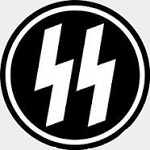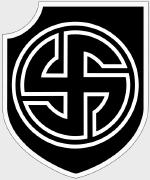Minichamps MIN350013001 German Sd. Kfz. 182 PzKpfw VI King Tiger Ausf. B Heavy Tank - Unterscharfuhrer Georg Diers, "314", schwere SS Panzerabteilung 503, 11.SS Panzergrenadier-Division "Nordland", Berlin, 1945 (1:35 Scale)
"If the tank succeeds, then victory follows."
- Major-General Heinz Guderian, "Achtung Panzer!"
 In January 1943, a new Tiger tank was ordered by the Waffenamt, this time with a turret large enough to mount the fearsome 8.8cm L/71 gun. Besides improving its tank killing capabilities, the new Tiger was also intended to be more survivable on the battlefield. To achieve this, the thickness of the frontal armor was increased to 150mm, while the side armor remained constant at 80mm. A wooden mock-up showing the immense size of the vehicle was displayed on October 20th, 1943 and immediately became the center of attention to all that saw it. Production of the vehicle began soon thereafter in November 1943 although the first 50 vehicles sported the Porsche turret with its curved front plate.
In January 1943, a new Tiger tank was ordered by the Waffenamt, this time with a turret large enough to mount the fearsome 8.8cm L/71 gun. Besides improving its tank killing capabilities, the new Tiger was also intended to be more survivable on the battlefield. To achieve this, the thickness of the frontal armor was increased to 150mm, while the side armor remained constant at 80mm. A wooden mock-up showing the immense size of the vehicle was displayed on October 20th, 1943 and immediately became the center of attention to all that saw it. Production of the vehicle began soon thereafter in November 1943 although the first 50 vehicles sported the Porsche turret with its curved front plate.
On December 6th, the Waffenamt deemed that the shot-trap formed by the turret be eliminated. This was achieved by Henschel re-designing the turret and gun mantlet, in such a manner as to decrease the frontal area while at the same time incorporating a bell-shaped mantlet. By March 1945, 489 Royal Tigers (a.k.a.
Konigstigers or "King Tigers") had been produced. Apart from five vehicles issued to the Feldherrnhalle division, all of the Tiger II heavy tanks were assigned to independent schwere Panzer detachments due to the tank's staggering size and weight, as well as its relatively slow rate of maneuver.
This particular vehicle was commanded by
Unterscharfuhrer Georg Diers of schwere SS Panzerabteilung 503, attached to 11.SS Panzergrenadier "Nordland", then defending Berlin in the spring of 1945. Vehicle features a rotating turret, elevating gun, working suspension, and treads that are made of flexible metal links! Note: Vehicle does not come with a turret-mounted machine gun. Sold Out!
Dimensions:
Length: 11-inches
Width: 4-inches
Height: 4-inches
Release Date: October 2008
 Historical Account: "While the Empire Collapsed" - In the early morning hours of April 19th, 1945, four King Tiger tanks of schwere SS Panzerabteilung 503 under the command of Obersturmfuhrer Muller, rolled through the village of Klosterdorf north of Strausberg. The tanks were deployed east of of the Black Mountains, with their guns facing Pradikow-Grunow. One of the four Tigers was hull number 314, commanded by Georg Diers, gunner Wolf-Dieter Kothe, loader Alex Sommer, driver Willi Kenkel, and radio operator Bodo Harms.
Historical Account: "While the Empire Collapsed" - In the early morning hours of April 19th, 1945, four King Tiger tanks of schwere SS Panzerabteilung 503 under the command of Obersturmfuhrer Muller, rolled through the village of Klosterdorf north of Strausberg. The tanks were deployed east of of the Black Mountains, with their guns facing Pradikow-Grunow. One of the four Tigers was hull number 314, commanded by Georg Diers, gunner Wolf-Dieter Kothe, loader Alex Sommer, driver Willi Kenkel, and radio operator Bodo Harms.
The first Soviet tanks, supported by infantry, began to appear across a broad front around 1000 hours between Ihlow and Grunlow. At a range of approximately 400 meters, the Tigers opened fire and quickly destroyed around 40-50 Soviet T-34 tanks. Nevertheless, the hilly terrain allowed many of the Soviet tanks to escape disaster and seek cover. Furthermore, the Tigers' defensive position became untenable as burning tanks billowed thick smoke reducing visibility. On the other hand, their machine gun fire caused considerable losses and forced the Soviet infantry to withdraw.
After the first wave of tanks, the Soviets attacked again at around 1400 hours across a broad front. By 1600 hours, the attack had failed. Without a single loss, four King Tigers managed to destroy 105 of over 400 Soviet tanks. Later, supply vehicles brought up badly needed fuel and ammunition. Two Tigers were then re-deployed about 800 meters back within the forest while the two remaining Tigers stayed in position for security purposes. Shortly thereafter, the forest erupted from a Soviet rocket barrage. Both tanks and crews, except for two men, were lost. Ostuf. Muller was among the dead.
Low on ammunition, Feldwebel Korner and Diers maintained their positions. That would soon change. Along the heights between Ihlow and Reichenow, at a distance of approximately 1800 meters, four hay piles came under observation. Through his binoculars, Georg Diers recognized the silhouette of a 122mm Joseph Stalin tank that had fired at them. He also witnessed a fireball coming from one of the piles of hay and a projectile sailing through the air. Shortly before it impacted his turret, Diers managed to duck down within the tank. The Soviet round tore the tank's vision blocks apart, ripped the hatches off the tower, and partially blew off the conning tower from the turret. The telescopic sight was also damaged, which rendered the tank inoperable. Tiger 314 was driven to a repair facility on a farm in Atlandsberg for major overhaul.
On April 30th, 1945,
Unterscharfuhrer Georg Diers and his crew of tank 314, were ordered to take up a defensive position at the Reichstag buildings. Diers tank was one of only two remaining King Tigers belonging to Heavy SS Tank Battalion 503 in Berlin. By that evening they had knocked out about 30 T-34s, and the following day led a successful counterattack against the Kroll Opera House directly opposite the Reichstag. Their efforts though, merely postponed the inevitable and by the end of the day, the order was given to abandon the position and prepare to break out of Berlin.
Amazingly, Tiger tank "314" ended the war with 39 kills and, despite the carnage engulfing Berlin in 1945, its crew survived the war.
Note: This vehicle serves as the focal point in David Pentland's painting, "Defence of the Reichstag, Berlin, May 1st, 1945."





 diecast items
diecast items 


